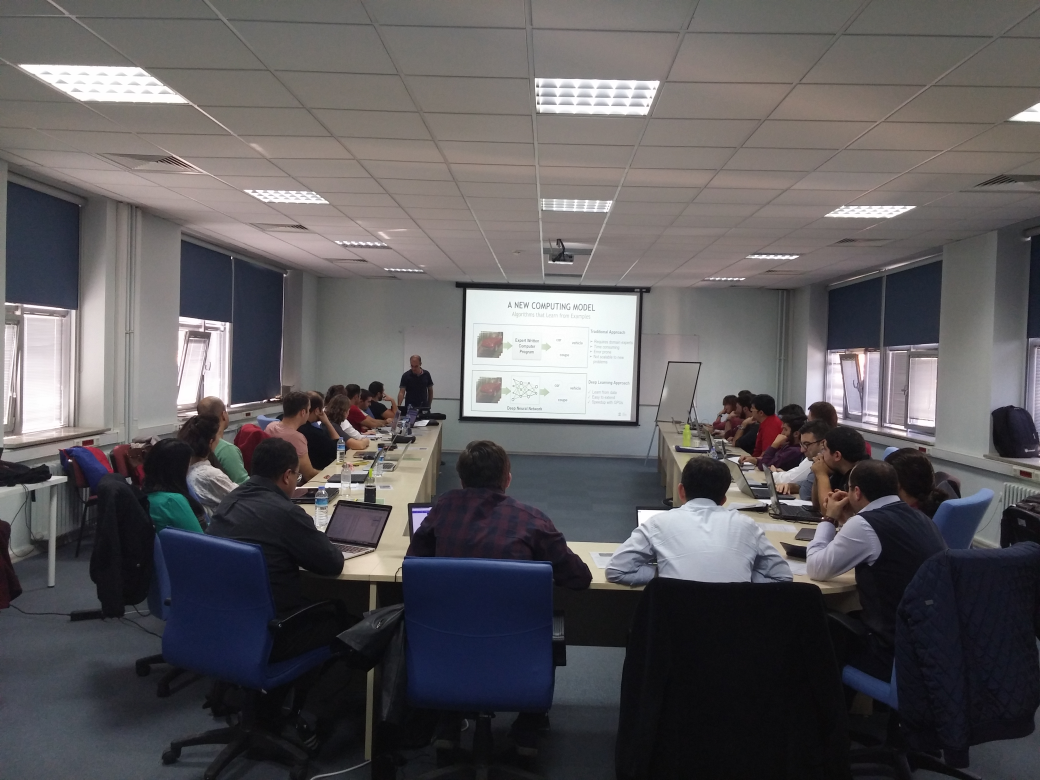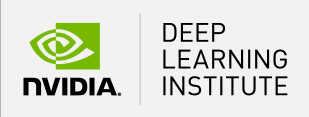Health Informatics Department November 2017 PhD Proficiency Exam
The written examination will be held on November 23-24, 2017 at the B-116 meeting room.
Written Exam start time 10:00
The written examination will be held on November 23-24, 2017 at the B-116 meeting room.
Written Exam start time 10:00
Thanks for attending the workshop! There was a lot of demand for the event but we were only able to accommodate around 40 participants, we are planning to have another one soon.
Dr. Alptekin Temizel
 |
 |
DLI and Graduate School of Informatics, Middle East Technical University (METU) are excited to announce this half-day practical Deep Learning workshop at Graduate School of Informatics on 21st October 2017 Saturday.
Students have to complete weekly online quizzes to get a participation grade. There is no defined class hours, no attendance required.
Eğer FAQ sayfasında açıklanmayan sorularınız varsa is100@metu.edu.tr adresinden bize ulaşabilir ya da https://ii.metu.edu.tr/is100 sayfasında verilen günlerde ve saat aralıklarında bizi 0312 210 37 39 numaralı telefondan arayabilir veya Enformatik Enstitüsü B-103 IS100 Help Desk odasını ziyaret edebilirsiniz.
Mailleriniz mümkün olan en kısa sürede cevaplanmaktadır.
Enformatik Enstitüsü idari personelinin konu hakkında bilgisi ve yetkisi bulunmamaktadır. Sorular sadece mail veya HelpDesk aracılığı ile cevaplanacaktır.
Course Code: 9010100
Bilişim Sistemleri EABD Yüksek Lisans Programı öğrencisi Hacer Güner, "FIRST IMPRESSION MATTERS: EVALUATING THE DESIGN OF UNIVERSITY WEBSITES IN TURKEY" konulu tezini, 07 Eylül 2017 tarihinde saat 13:00'da A-212 no.lu toplantı salonunda savunacaktır.
Tez Özeti : Hızla gelişen teknolojinin hayatımızın her alanında yaygın olarak kullanılmaya başlanması ile birlikte, insan ve bilgisayar arasındaki etkileşimin dikkatle ve özenle araştırılması ihtiyacı doğmuştur. Üniversiteler de dâhil olmak üzere neredeyse tüm kurum ve kuruluşlar, sağladıkları bilgi ve hizmetleri çevrimiçi ortamda taşıma eğilimine uyarak kurumsal internet sitelerine sahiptir. Kurumsal internet sitelerinin genel olarak kurumların sanal vitrinleri olarak görülmesi, bu sitelerin tasarımı üzerine odaklanmayı gerekli kılabilir. Yapılan çalışmalar, kullanıcıların internet sitelerine ilk girdiklerinde oluşan izlenimin ve duygusal tepkilerin kullanıcı tatmini ve kuruma karşı duyulan güven üzerinde önemli bir etkisinin olduğunu göstermektedir. Bu çalışmanın amacı, kullanıcılarda üniversite internet sitelerine yönelik oluşan ilk izlemi ve ilk izlenimi şekillendiren faktörleri incelemektir. Çalışma kapsamında, 2014 yılı TÜBİTAK raporu verilerine göre, Türkiye’de yenilikçilik ve girişimcilik alanında ilk 10’da yer alan üniversitelerin internet sitelerinin tasarımları üniversite öğrencileri tarafından değerlendirilecektir. Seçilen 10 üniversitenin internet sitesi, her kullanıcı için farklı sırada olacak şekilde gösterilecektir. Katılımcılardan verilen internet sitelerin ana sayfalarını ilk izlenimleri oluşuncaya kadar incelemeleri istenecektir. Her bir internet sitesini inceledikten sonra katılımcıdan verilen anket sorularına göre siteye karşı edindiği duygu ve izlenimleri değerlendirmesi istenecektir. Bunun yanında, göz izleme teknolojisi yüksek sesle düşünme tekniği ile birlikte kullanılacak; kullanıcıların site ara yüzünü incelerken ne yaptıkları, nereye baktıkları, ne aradıkları ve ne düşündükleri hakkında yorumlarını söylemeleri istenecektir. Çalışma sonuçlarının kullanıcıların üniversite internet sitesine yönelik beklentilerini belirlemede rehberlik etmesi öngörülmektedir.
Bilişsel Bilimler EABD Yüksek Lisans Programı öğrencisi Ahmet Üstün, "PROBABILISTIC LEARNING OF TURKISH MORPHOSEMANTICS BY LATENT SYNTAX" konulu tezini, 08 Eylül 2017 tarihinde saat 11:00'da B-116 no.lu toplantı salonunda savunacaktır.
Tez Özeti : Insanların dil işleme yeteneği, dilbilgisi olarak formalize edilen sözdizim ve anlambilim arasındaki arayüze oldukça bağlıdır. Turkçe gibi morfolojisi zengin dillerde, morfoloji bu arayüze müdahale eder. Bu tez düzelsen morfolojik anlambilgisiden altında yatan gizli sözdizimi ile kelimelerin anlamlarını keşfetmeyi amaçlamaktadır. Bu bağlamda, içindeki her morfemin sözdizimsel kategori ve anlamsal bilgi taşıdığı bir morfem sözlüğü öğrenmek için gereken model geliştirilmiştir. Kelimelerin içindeki olası morfemleri tespit etmek için kelimelerin dağılımsal özelliklerini kullanan bir bölümlenme algoritması, bu olası morfemlerin sözlük içindeki ağırlıklarını Öğrenme için ise olasılıksal ulamsal dilbilgisi kullanılmıştır. Türeme türemiş kelimelerin ayrıca ele alınması ile çözülebildiği için, bizim modelimiz yapım ekleri üzerine eğilmektedir. Tez kapsamında model test edilmiş ve sonuçlar farklı yönleri ile rapor edilmiştir.
Bilişsel Bilimler EABD Yüksek Lisans Programı öğrencisi Tuğçe Nur Bozkurt, "WORD LENGTH AND SUFFIXATION ON EYE MOVEMENT CONTROL IN TURKISH READING" konulu tezini, 07 Eylül 2017 tarihinde saat 16:00'da A-108 no.lu toplantı salonunda savunacaktır.
Tez Özeti : Okuma araştırmalarındaki bulgular, gözlerin okuma sırasında rastgele hareket etmediğini; bunun yerine okumanın altında yatan bilişsel süreçleri inceleyebilmeyi sağlayan örüntüler izlediklerini ortaya koymaktadır. Yakın zamandaki araştırmalar, okumadaki leksik etkilerin başlıca ölçütü olarak bir kelime üzerindeki ilk sabitlemeyi sunmaktadır. Kelime üzerindeki sonraki sabitlemelerin genellikle ilk sabitlemeden farklı rollere sahip oldukları varsayılmaktadır. Bu çalışmada, soneklemenin rolü göz önünde bulundurularak, ilk sabitleme ile sonraki sabitlemeler arasındaki ilişki araştırılmıştır. Okuyucuların sabitleme stratejileri, göz hareketleri örüntülerini etkileyen faktörler kontrol edilerek iki deneyde incelenmiştir. Sonuçlar, bireysel sabitlemelerin analizi yoluyla kısa ve sık kullanılan sözcükler için sözcüksel işlemedeki biçimbilimsel etkileri ortaya koymaktadır.
Sağlık Bilişimi EABD Yüksek Lisans Programı öğrencisi GİZEM GÖKTEPE, "EFFECT OF BILATERAL SOMATOSENSORY STIMULUS ON OSCILLATORY BRAIN ACTIVITY AND LONG TERM MEMORY" konulu tezini, 07 Eylül 2017 tarihinde saat 16:00'da B-116 no.lu toplantı salonunda savunacaktır.
Tez Özeti : Bir psikoterapi yöntemi olan göz hareketleriyle duyarsızlaştırma ve yeniden işleme (EMDR) yöntemi iki taraflı sakkadik göz hareketleri, işitsel ve dokunsal uyaranlar kullanarak travmatik anılara daha kısa sürede ulaşılması ve bu anıların olumsuz etkisinin azaltılmasında kullanılmaktadır. Şuana kadar yapılan araştırmalarda kullanılan iki taraflı uyaranların etkisine dair henüz kabul edilmiş bir sonuç bulunmamaktadır. Bu tez çalışmasında, iki taraflı somatosensöriyel uyaranların salınımsal beyin aktivite ve uzun süreli hafızadaki etkisi incelenmiştir. Bu doğrultuda, bellek kodlama ve bellek tanıma olmak üzere iki ayrı bölümlerden oluşan özgün yüz tanıma paradigması tasarlanmıştır. Bellek kodlama bölümünde; asyalı, siyahi ve beyaz olmak üzere 3 farklı etnisiteden oluşan eşit dağılımlı 240 yüz imgesi 20 üniversite öğrencisine gösterilmiştir. Bellek tanıma bölümünde, somatosensöriyel uyaran kullanıldığında ve kullanılmadığı sırada, deneklere toplamda 336 yüz imgesini (240 eski, 96 yeni) daha önceden görüp görmedikleri sorulmuştur. EEG kaydı sadece bellek tanıma işlemi esnasında alınmıştır. Analiz sonuçları, iki taraflı somatosensöriyel uyaranların bellek tanıma öncesi sol pariyetal-oksipital kanallarda ve karar verme sırasında sağ pariyetal-oksipital kanallarda alfa aktivitesini arttırdığını göstermiştir. Ayrıca, uzun süreli hafıza performansını arttıran deneklerde, iki taraflı somatosensöriyel uyaran kullanıldığında, frontal kanallarda alfa aktivitesinde önemli bir artış saptanmıştır. Bu çalışma, iki taraflı uyarımın salınımsal beyin aktivitesinin modifikasyonu ile uzun süreli bellek performansını değiştirebileceğini ortaya koymaktadır.
Bilişsel Bilimler EABD Yüksek Lisans Programı öğrencisi Zuhal Ormanoğlu, "PERCEPTUAL SPAN IN TURKISH READING: A STUDY ON PARAFOVEAL INFORMATION INTAKE" konulu tezini, 07 Eylül 2017 tarihinde saat 14:00'da A-108 no.lu toplantı salonunda savunacaktır.
Tez Özeti : Algılama aralığı, bir sabitlemede (fixation) toplanabilecek işlevsel bilginin alındığı görsel bölgeye verilen isimdir. Bu tezde Türkçe okuyucularının algılama aralığı araştırılmıştır. Rayner (1975) İngilizce okuyucuları için algılama aralığını sağa doğru 14-15 karakter, sola doğru 3-4 karakter olarak belirlemiştir. Ancak dilin karakteristikleri algılama aralığının boyutu üzerinde etkili olmaktadır. Türkçenin sığ ortografiye sahip ve yapışkan (agglutinative) bir dil olması, okuyucuları üzerinde kolaylaştırıcı etkiler yapabilir. Bakışa bağlı hareket eden pencere paradigması kullanılan deneyde (N=48), paragrafın tamamının gösterildiği durum ile beş farklı pencere boyutu karşılaştırılmıştır (bakışın sağına doğru 7, 11, 15, 19 ve 23 karakter açılan pencereler). Doğal okuma koşullarını canlandırmak amacıyla, katılımcılara tek cümleler yerine paragraflar okutulmuştur. İlk sonuçlar birinci bakış süresi, bakış süresi, içeri regresyon sayısı, dışarı regresyon sayısı ölçütlerinde bütün paragraf durumu ile diğer beş pencere durumu arasında önemli bir farklılığa işaret etmektedir. Okuma oranında ciddi bir farklılık gözlenmemiştir. Bu durum, parafoveal kısıtlamanın Türkçe okuyucular üzerinde farklı etkiler yapabileceğini, bu nedenle, Türkçedeki algılama aralığının daha geniş bir açıdan ele alınması gerektiğini göstermektedir.
©2017 METU Graduate School of Informatics. All rights reserved.
Design: CC-IG